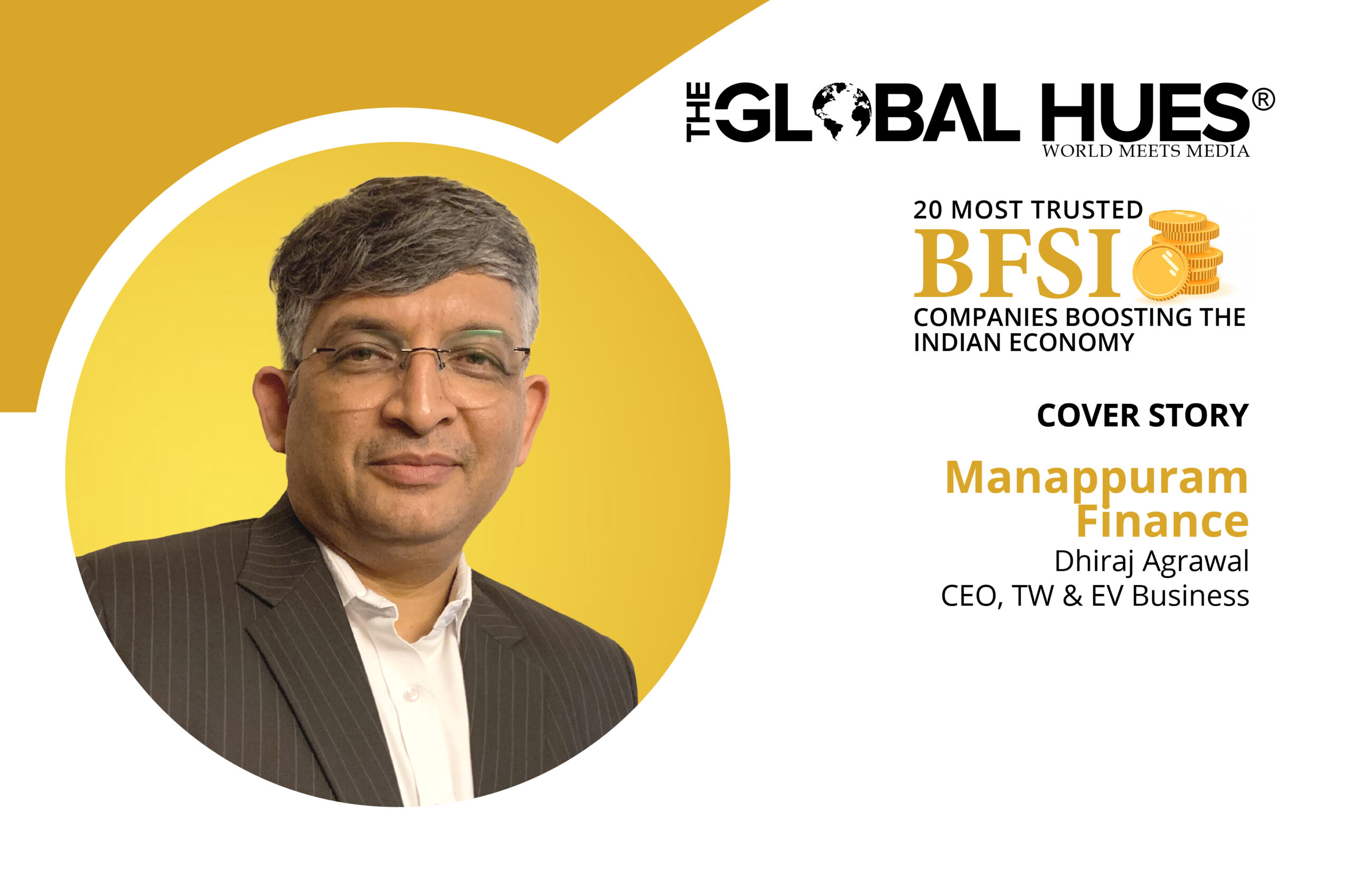Dhiraj Agrawal – CEO TW & EV Business of Manappuram Finance shared his thoughts about the growth and success of the company with The Global Hues.
Manappuram Finance Ltd. is one of India’s leading NBFCs dominant in gold loans besides an active presence in microfinance, vehicle and equipment finance and home loans. Incorporated in 1992, Manappuram Finance Ltd. has grown at a rapid pace. Today, it has 4600+ branches across 28 states/UTs with assets under management of about Rs. 276 billion and a workforce of over 28,000. Dhiraj Agarwal is the CEO of Two-wheelers(TW) and the Electric Vehicles(EV) Business in Manappuram Finance Ltd. EV finance, a part of the Vehicle finance group, is a very new business for Manappuram Finance.
The business in this sector has been growing for the last 2yrs consistently. Finance is the foremost factor that is affecting the vehicles to be financed in India. 60% of the EV’s are being financed and mostly through private companies or by Nationalized banks. Non- Banking Financial Companies (NBFCs) are not very much interested in funding these risky profiles which offer good prospects if the product is financed by taking all the necessary precautions, considering all the credit and risk parameters in depth.
“According to our analysis of future passenger and freight vehicle sales, India’s weighted-average EV sales penetration has the potential to be about 70 percent in 2030. This value is based on forecasted cost competitiveness and expert interviews,” said Dhiraj.
The quantum of finance required for this EV adoption scenario is considerable. Between 2020 and 2030, the estimated cumulative capital cost of the country’s EV transition will be INR19.7 lakh crore (USD266 billion)—across vehicles, electric vehicle supply equipment (EVSE), and batteries (including replacements). The estimated size of the annual EV finance market will be INR3.7 lakh crore (USD50 billion) in 2030.
As the economics of electric vehicles (EVs) continue to improve and new business models gain acceptance, India’s EV market is poised for significant growth in the coming decade. “The EV sector is growing and has more potential as compared to the other products so we entered into this business,” said Dhiraj.
Financial issues in the EV segment

Dhiraj has identified 10 solutions that financial institutions (FIs), the EV sector, and the government can adopt to help mobilize the capital and financing associated with India’s EV transition. These include six targeted instruments and four ecosystem enablers:
TARGETED INSTRUMENTS
- Priority sector lending (PSL): The Reserve Bank of India (RBI) requires 40 percent of net bank credit to be deployed towards priority sectors. Inclusion of EVs in PSL guidelines would incentivize banks to increase lending towards the sector.
- Interest rate subvention: Subventions act as a subsidy on commercially offered interest rates, with the government bearing the balance through associated banks. Such schemes would substantially improve the affordability of loans. They have already been enacted in other sectors and at a state level for EVs in Delhi.
- Product guarantees and warranties: Reducing the uncertainty associated with EV models will improve their bankability. Original equipment manufacturers (OEMs) can provide assurances in the form of guarantees (to FIs) and warranties (to buyers) on the performance of their products.
- Risk-sharing mechanism (government and multilateral-led): Mechanisms and facilities that partly or entirely cover possible losses associated with financing EVs (due to their unclear resale value) can be capitalized at the national or multilateral level. These would distribute risk and provide FIs with an opportunity to build their trust in the sector.
- Risk-sharing mechanism (fleet operator-led): Fleet operators and final-mile delivery companies can leverage their existing FI relationships to provide partial credit guarantees and utilization guarantees to driver-partners. They could share the risk between stakeholders in case of default and enhance loan availability for delivery drivers
- Secondary market development: Industry-led buyback programs and battery-repurposing schemes will help OEMs and the central government catalyze a secondary market for EVs. This would improve the residual value of EVs, providing FIs with an avenue for resale in case of borrower default.
ECOSYSTEM ENABLERS
- Digital lending: Digital sourcing, underwriting, and sanctioning can streamline EV loans by helping overcome the operational and logistical challenges of vehicle financing.
- Business model innovation: Piloting and commercializing new business models, combined with the flow of patient capital, can demonstrate the potential of the sector. Additionally, they would help build trust in EVs and normalize them in the market.
- Fleet and aggregator electrification targets: The electrification of final-mile delivery, ride-hailing, and corporate transport fleets can act as a strong market signal for stakeholders across the ecosystem, especially OEMs and FIs.
- Open data repository for EVs: FIs need access to data on EV specifications, real-world drive cycles, actual charging costs, and operating expenditures. This will help such institutions accurately assess risk, determine appropriate interest rates, and design effective leasing programmers.
Impact of New Trends in the EV market on Financial Companies

“EVs are going to rock and it’s full of opportunity for each stakeholder from EV OEM to Charge Point Operators,” stated Dhiraj. The moment financial companies overcome some key issues like cost, range, and availability of Charging facilities, EVs are going to be in full swing. Dhiraj believes these issues will get a corner in the next 2-3 years’ time as the market is changing at a fast pace and lots of R&D is going on in this sector.
Aatmanirbhar Bharat will have many impacts where the cost of the battery will be reduced to half and price will become affordable to all. “Just get ready for this EV STORM and make your mind that your next vehicle would be an Electric Vehicle,” said Dhiraj.
Difference between 2W Electric Vehicles and 3W financing
The products EV & two- wheelers (2W) are very different. The profile of both the customers is very different. “One of the main reasons behind buyers not going for an electric vehicle is the high ownership cost. Given the current trends in battery pack technology, it would take another three to five years before batteries are available at such price points in India,” explained Dhiraj.
Moreover, the majority of profiles are very risky as they are daily earning customers. Therefore, Manappuram has to design their services in a way where they take the EMI daily, either through branch deposit or through the online platforms. This helps the company to mitigate risk in financial processing. Manappuram Finance manages to convince the customer to pay the EMI in time so that they can make more loans by creating the credit history with the bureau.
Challenges faced by the EV market in India
“Only a few of the NBFCs/Banks/MFIs present in tier 2/3 cities do consumer financing for e-rickshaws and electric bikes with varying interest rates, LTVs, and SLAs. This slows down momentum for small enterprises and dealers looking to sell EVs to potential customers for livelihood generation in these small cities,” said Dhiraj.
Strategies to improve operational efficiency and enhance the customer experience

Many studies show the charging stations required for EVs are operated inefficiently. Many drivers keep charging the car while parked, occupying the space of the charging station and preventing access to other cars. An efficient strategy is needed in place to overcome this issue and create a budget for charging stations. A great advantage of Electric Vehicles is that they help in reducing greenhouse gas emissions.
A ray of hope in the future to keep a check on ever-increasing pollution and improve the air quality index. The main barrier in the purchase of EVs is limited range, high-cost batteries, high prices of vehicles, and fewer charging stations. Installation of public charging stations at easily accessible places is the need of the hour.
Major impacts of Covid-19 in the BFSI space

Manappuram has started EV finance 2 years back and received a great response. They managed to do decent numbers with all major manufacturers in India. “We work at all levels in India covering all the major cities,” said Dhiraj. The business for Manappuram involving normal two-wheelers was as usual. Even post COVID the business is expected to improve further due to social distancing norms. People will avoid traveling by public transportation like Metro and bus and will either buy TW or take on rent.
“COVID-19 is just another bump in the road, but at the same time, it’s indicated that EVs are one option to solve the problem of pollution. The new normal has, for sure, a special place for EVs as well given the changing work culture and mindset of the people,” said Dhiraj.
The world during and post the global COVID-19 pandemic is certainly going to change the way people move around, especially in a population-dense country such as India. The global index for ride-sharing platforms was expected to grow at 20% CAGR in the pre-COVID era from $ 61.3 billion in 2018 to over $ 218 billion by 2025.
The Indian electric vehicle (EV) market will continue to be largely driven by the two-wheeler and three-wheeler segments. The time frame is the next quarter that plays a key role in business. During the festival season, the sales are expected to pick up. The Covid-19 situation will soon be under control with a vaccination drive in progress. Markets will come back to normal by next year i.e. 2022.
Current Roadblocks
In Dhiraj’s view, the main issue in EV finance is the OEM stability and products. The models which are being made are from China and came as CKD units in India and are freshly made. Therefore, the company has to check the quality of the product. Many NBFCs are not interested in funding these vehicles due to quality issues. So the Government of India should make an organization for all NBFCs as well as OEMs to promote this model.
Awards and Milestones


- The first NBFC in Kerala to receive a Certificate of Registration issued by the RBI.
- One of the earliest to go for an IPO in 1995.
- In 2007, it became the first Kerala-based NBFC to receive investment from foreign institutional investors (FIIs) when the celebrated PE fund, Sequoia Capital, invested Rs.700 million along with Hudson Equity Holdings.
- Manappuram Finance Ltd. was the first NBFC in Kerala to obtain the highest short-term credit rating of A1+ from ICRA.
- In 2010, it became the first Kerala-based NBFC to offer ESOPs (Employee Stock Option Plan) to its middle and senior management functionaries.
- Mr. Dhiraj won the Big 40 NBFC Excellence Award at the World AI Show.
- Has addressed many seminars, webinars, and events to speak on topics like AI and EV.
Also Read:
- PTC India Financial Services Limited: Expert In Financing Sustainable Infrastructure Sectors
- Insurance Samadhan: A Tech Platform For Resolving Insurance Grievances
- Indian School Finance: Longest-Standing Flagship Investments In Education
- Gyandhan: Offering Sustainable Education Financing
- P.C. Financial Services: Disbursing Unsecured Cash Loans
- Ginger Root Code Factory: Delivering Extraordinary IT Solutions
- Quale Infotech: Intelligent Automation Platform Digitizing BFSI
- MAKSPay Fintech Solutions: Promoting Financial Inclusion




